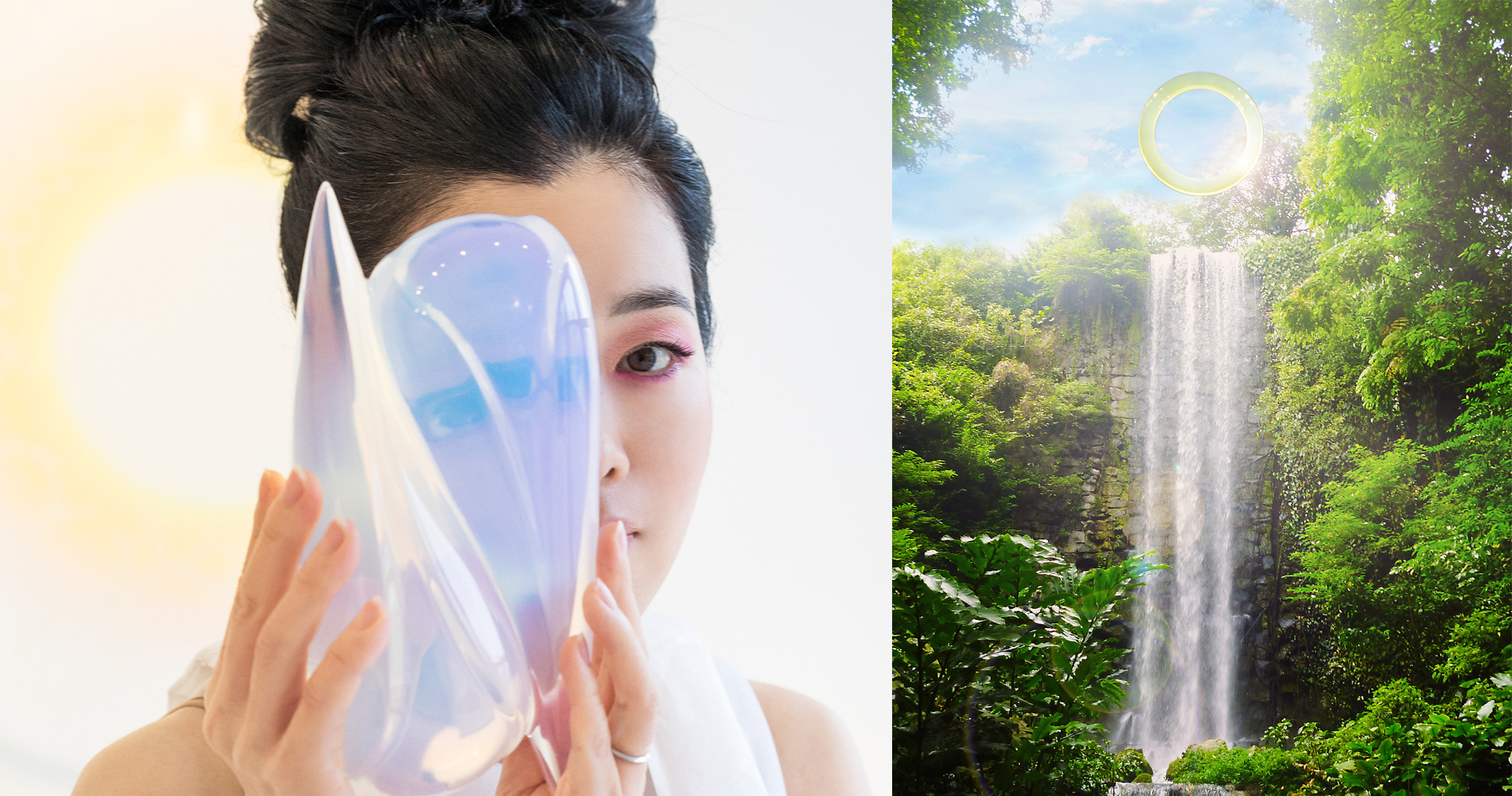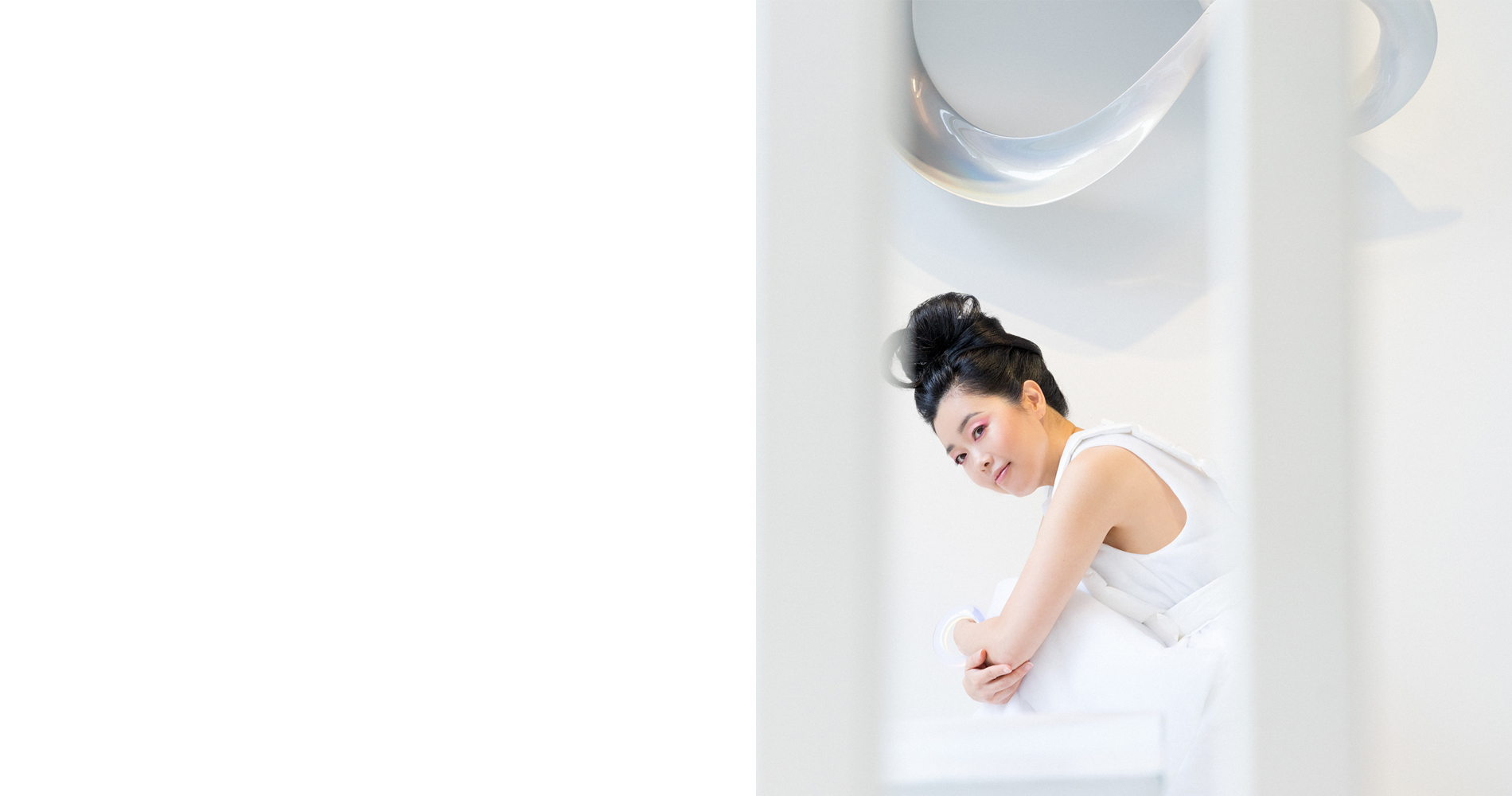Time and again Mariko Mori has succeeded spectacularly in representing what is beyond representation. The eternal cycle and power of art to transcend and unify. Prior to visiting and photographing Mori within her serene, all white Manhattan studio, my most recent encounter with her work was at the Art Institute Chicago, where I experienced her video piece from 1996, Miko No Inori. An aesthetic alien dream, the work is composed of Mori as a sleek otherworldly creature with an icy blue gaze rolling a clear glass orb in her elegant hands amid the glossy reflective surfaces of Osaka’s Kansai International Airport. Twenty years later that work feels eerily relevant, a prophetic foreshadowing of our current condition. Now we can project our individuality through our perpetual connectivity to our cell phone screens, creating the world as we see it and how we see ourselves within it. Since her breakout on the international art scene in the 1990’s, Mori’s vision has expanded and evolved through different mediums. In 2010 Mori established the nonprofit Faou Foundation, an organization whose mission is to create art as a symbol for the peace and harmony that is within each of us. Each of the six installations set in a location rich in natural wonders spread across six continents. In light of Mori’s second installation which will be unveiled this summer, I had the chance to chat with and capture the artist who embodies the optimism of her ideals and whose reach is set to become exponential.
Pari Dust: Your enchantingly beautiful upcoming project called the Ring will be installed over the Treze waterfall in Rio De Janeiro for the 2016 Olympics. The ring-shape clearly connects to the Olympic symbol of five overlapping rings that represents the five continents. Your translucent Ring makes a sixth, and you’ve placed it in an inspiring natural setting, connecting it to nature. The ring-shape itself made me think of what Aristotle wrote about the circle, declaring it was “the perfect, first, most beautiful form.” Zen Buddhism also considers the closed circle a representation of perfection. Does the idea of perfection play a role in this work for you?
Mariko Mori: It is true that the sixth ring is to connect nature and the human being. The ring form has many different meanings, the one that you mentioned Zen Buddhism it is the form of reincarnation also symbolizing the concept of oneness, connecting macro world to micro world not only human beings but every living being is seen as a whole and seen as one. We are part of a whole and we are one with a whole but at the same time we are individuals, every living thing has its own universe. That is what the ring symbolizes in the Buddhist philosophy.
When you say perfection, it is a difficult term because our observation or expectation of perfection may not be true perfection. What we have here is everything is perfect and every living being and everything that exists is perfect including humans. In a way we are in a perfect world we just may not project it. If we don’t project perfection we don’t bring it.
As well, ring in Japanese is wa, wa means harmony. Harmony with everything. Those three elements are the meaning of this form, the ring.
Apparently the ring will change colors throughout the day? That sounds magical. Can you talk about the materials and your use of technology in this project?
The material is a layered acrylic, but it is a very special acrylic, the material itself is as pure as you can get, therefore it is very stabilized. Between the layered acrylic I apply different colors in each layer. Also the form, the combination of the form and the different colors within the layer, when the sun hits or any light hits the surface it will change the color accordingly. It depends on the sun’s position, if its a cloudy day or rainy day, it depends on the volume of the light and angle, the work does change color.
You’ve collaborated with so many people from a vast range of fields over the course of your career. You’ve touched on cutting edge technology, architecture, engineering, even quantum physics. Collaborating with others and being able to pull the best out of people is a skill unto itself. Did this always come easily to you?
First of all it is very pleasurable to share ideas with engineers, collaborators, craftsmen and so on. It is a true collaboration. For some work, hardware and software engineers need to develop new technology because no one has done it before and everyone has to push themselves to open a door that has not been opened. Those challenges always push ourselves to deliver a new way or new technology. It is really wonderful to share those challenges with all of the specialists. Because of those challenges we manage to communicate and understand each other and when the work is done those accomplishments are very pleasurable for us. It is not a matter of controlling it is just a matter of sharing the challenge and doing it together.
Has a project ever been influenced by the people you’re working with or changed as your knowledge expanded in the field you’re exploring?
Yes of course, because sometimes the technology was not available so I learned what could be done. Sometimes I learned that if I wait then, the technology will come. All the knowledge that we shared with engineers and scientists, it really inspires me. Also I think other scientists are pushing their limits and expanding their imagination and those kind of attitudes give me courage to push myself as well.
So often your work creates a harmonious interface of nature and technology and projects a serene, optimistic vision of our world and its potential. The Olympics embraces a unified, optimistic view of humanity as well, yet sometimes it seems the world is very much at odds with this ideal, especially in view of current events, both politically and environmentally. How do you feel about the dissonance between our collective desire for harmony and our less perfect reality?
I think when I spoke earlier about the ring and perfection and wa meaning harmony, we have to realize that every living being and every human being is equal, we all came from the same mother, the evolution of homo sapiens from 200,000 years ago. We came from the same origin, the genes we all share with 99 percent of the whole world. Physically we are all brothers and sisters and our mind knows that we are equal but somehow we have built walls between us with different beliefs, those are superficial walls that we built through the history of mankind. But we were united before, we were one before and we came from one mother. Also if you look at prehistorical culture as a monument we had the same one belief which was to honor nature and ancestors. Through this we believe that we can become one again.
You started off as a high fashion model in Japan in the 1980’s and often designed and made your own clothes. Do you feel your background in fashion influences your current practice in any way?
Through the experience of being inside the fashion industry, this is where I learned to create an image. Also that through the imagination you are able to create visuals, so the process from imagination to realization. It was very joyful, so continuing to enjoy and to do this realization of vision those skills are kind of similar, it is my base. Now I use a different media or a different language, the language of art, but the fundamental practice is the same.
Your installations create powerful frameworks of experience for the viewer. What do you hope the viewer takes away from viewing the Ring?
The artwork is there to bring people into nature. When you are standing in front of this beautiful pristine nature it will reflect on you. In a way I hope that the work will make people realize that you are also nature. I hope that you will create an inner harmony so that you will create the ring within yourself, then we will have many, many individual rings so that we can bring all the change.
Mariko Mori is wearing Melitta Baumeister, a designer who appropriates techniques from sculpture, architecture and fine art to explore new realms in materiality.
Mariko Mori, Faou Foundation
Makeup by Samantha Dametta, Hair by Cosma De Marinis, Styled by Pari Ehsan, Photographs of Mariko Mori by Robert Michael

